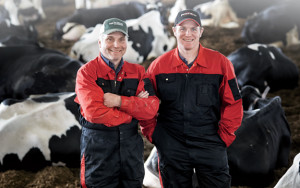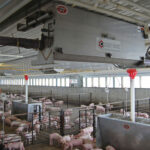Robotic Revolution
It’s just one of those talks that you have while you’re milking the cows,” says Todd Schnarr. “You know, ‘What do you want to do next?’” he recalls asking his dad and business partner. “‘Where do you think we’re going?’...
Robotic Revolution
It’s just one of those talks that you have while you’re milking the cows,” says Todd Schnarr. “You know, ‘What do you want to do next?’” he recalls asking his dad and business partner. “‘Where do you think we’re going?’...It’s just one of those talks that you have while you’re milking the cows,” says Todd Schnarr. “You know, ‘What do you want to do next?’” he recalls asking his dad and business partner. “‘Where do you think we’re going?’
“We were just way too overcrowded,” says Todd’s father, Murray. “We had to get these cattle moved into an area where they had a lot more freedom, a lot more space and a lot more cow comfort.”
The Schnarrs, who live and work near Alma, Ontario, found what they hoped would be a solution, consisting of two main parts, each working hand in hand with the other. One was a compost-pack barn that would give the cows the freedom to move about inside, which, in turn, would allow them to essentially milk themselves at the second part of this equation: a robotic milking system.
Pioneered in Europe some 20 years ago, significant numbers of dairies in Canada, and more recently the U.S., have begun installing robotics, also referred to as automatic milking systems (AMS). The robotic system the Schnarrs purchased cost them about $400,000. Even with a total cost of $1.7 million, including construction of the new compost pack barn, Murray and Todd hope the system will pay for itself—mainly in the form of increased yields and lower labor costs—in six to seven years from time of completion.
In addition to operating a dairy, Murray and Todd Schnarr run a custom hay cutting, raking and baling business. Farming a total of 550 acres, some of which is planted in cash crops, Todd says he and his dad don’t farm enough land for many new equipment purchases “to make financial sense. So we do custom work.”
That way, he says, he and his dad can spread the cost over multiple uses and “we can get top-quality equipment for our farm. I like helping neighbors, and this way it’s a win-win for us and for them.”
The “top-quality equipment” to which Todd refers is AGCO, including a Massey Ferguson® 8660 tractor, and a 2150 large square baler and 9770 windrower, both of which are Hesston® by Massey Ferguson. Todd says the fuel economy is excellent on the 9770 and MF8660, and the CVT transmission on the tractor makes “the equipment more efficient to run. You can get that exact mile per hour that you’re looking for. Half a mile an hour might not seem like much, but through a whole day or a week, you know you can get a lot of extra work done with that.”




